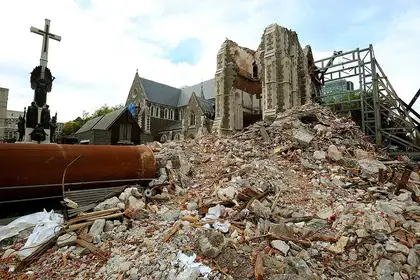
Maureen Mooney's PhD research addresses the resilience of children in Christchurch in the aftermath of the 2010-2011 Canterbury earthquakes.
Maureen Mooney has confronted crisis situations all over the world but returned to Christchurch to complete her PhD researching children’s behaviour in the aftermath of the Canterbury earthquakes.
Aside from being a researcher for the Joint Centre for Disaster Research based at Massey University’s Wellington campus she is also a Red Cross consultant, and is called upon to respond in volatile parts of the world devastated by earthquake (Haiti) infection by HIV virus (Cambodia) or civil war (Sudan).
Dr Mooney, who is a clinical psychologist trained in France, had her doctorate formally conferred on Thursday at Massey’s University’s graduation ceremonies at the Michael Fowler Centre.
She analysed children’s experiences of the 2010-2011 Canterbury earthquakes to determine how they cope with natural disasters, concluding that exposure to earthquakes appears to make many children in Christchurch more resistant to other pressures in life compared to children coping with the usual challenges of growing up.
Dr Mooney’s qualitative research involved interviewing 42 children from five schools in Christchurch aged five, nine and 15 years, along with children from several Wellington schools as a comparison group.
“All children were interviewed 20 months after the first earthquake during an ongoing aftershock sequence, and six selected children from Christchurch were interviewed again three years after the initial earthquake,” Dr Mooney says.

Maureen Mooney.
Dr Mooney found that the Christchurch children who dealt most effectively with the earthquakes had multiple coping strategies that they used flexibly, in comparison to the Wellington children who were mainly coping with challenges appropriate to their age.
“For example, children practised how to keep calm and used distraction as a coping strategy when they could not control the situation, but then used a problem-solving strategy when they could have some impact on their circumstances.”
Distractions included playing video games, texting friends or playing sports. Problem solving included suggestions about what to do in the event of an aftershock, Dr Mooney says. “They would use the Richter scale with me to say what they could do in a [magnitude] 4.5 or a 6. They had worked out where to go in whatever space they were in as well.”
Children who didn’t cope so well tended to use avoidance or withdrawal as a way of dealing with a situation, Dr Mooney says. In Christchurch, the parent/child and teacher/ child relationship often provided specific protective elements that helped the children during the earthquakes. “They purposely re-introduced the usual family or class rhythms, went on with lessons calmly after an aftershock, went out for walks, celebrated birthdays, etc to re-establish the children’s routines.”
Parents and teachers often helped processing or supporting children’s coping abilities as well as eventually encouraging a re-focusing on everyday tasks, she says.
“A few children had considerable inner resources and were able to take away positives from the situation. For example, a five year-old explained how he could support another child by telling them that the earthquake was probably only an aftershock – so ‘just a little one’.
“When children perceived that their community was exhibiting signs of recovery and competence, the neighbourhood and community appeared to have a positive effect on their sense of connectedness, local identification and promoted their sense of recovery,” Dr Mooney says.
It’s a lesson Dr Mooney repeated from her work of more than 17 years with the International Red Cross offering psychosocial support to vulnerable populations such as in Jordan working with Iraqi refugees, ambulance crews in Israel dealing with the aftermath of road accidents and terrorist attacks; and supporting HIV positive children in Cambodia and the Congo.
Next month she returns briefly to France, where she first worked for the Red Cross helping prisoners and populations facing disasters, to offer workshops to Red Cross colleagues dealing with displaced people anxious for news of loved ones who may not have made it safely to the European mainland.
“I’m interested in how people manage around adversity and what can be done to help them in a dignified way,” Dr Mooney says. It’s often the manner in which something is done that helps people and enables them to stand on their own two feet.”
A note on qualitative research: It is used to uncover trends in thought and opinion and investigate less researched areas more deeply. Data collection methods vary but can include focus groups, individual interviews and participation/observation. The sample size is typically small and respondents are selected to provide a detailed view of the issue.